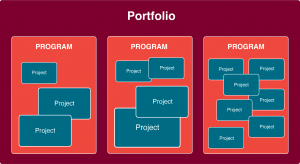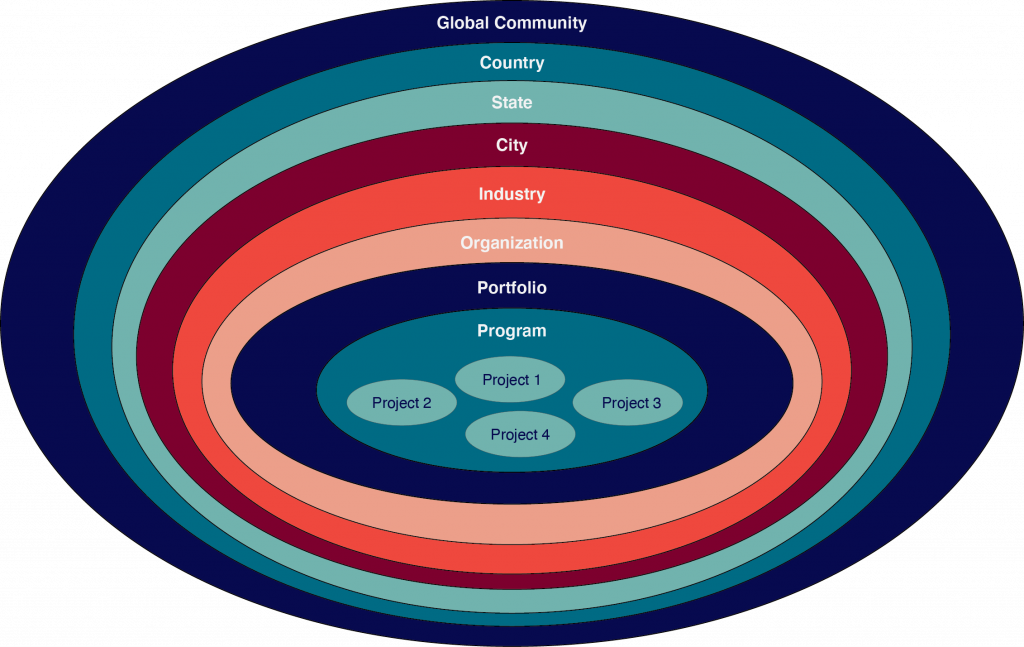2.4. Strategy
An organization without a clearly defined strategy can never expect to navigate the permanent white-water of living order. This is especially true if the strategy is motivated by the organization attempting to push its vision onto customers, rather than pulling the customer’s definition of value into its daily operations. An organization’s strategy is an expression of its mission and overall culture. In a well-run company, every decision about a project, program, or portfolio supports the organization’s strategy. The strategy, in turn, defines the company’s portfolio and day-to-day operations. Projects and their budgets flow out of the organizational strategy. Morgan et al. (2007) emphasize the importance of aligning a company’s portfolio with its strategy:
- Without clear leadership that aligns each activity and every project investment to the espoused strategy, individuals will use other decision rules in choosing what to work on: first in, first out; last in, first out; loudest demand; squeakiest wheel; boss’s whim; least risk; easiest; best guess as to what the organization needs; most likely to lead to raises and promotion; most politically correct; wild guess—or whatever they feel like at the time. Portfolio management still takes place, but it is not necessarily aligned with strategy, and it occurs at the wrong level of the organization (2007, p. 5).
As a project manager, you should be able to refer to your organization’s strategy for guidance on how to proceed. You should also be able to use your organization’s strategy as a means of crossing possibilities off your list. Michael E. Porter, author of the hugely influential book Competitive Strategy, explains that strategy is largely a matter of deciding what your organization won’t do. In an interview with Fast Company magazine, he puts it like this:
- The essence of strategy is that you must set limits on what you’re trying to accomplish. A company without a strategy is willing to try anything. If all you’re trying to do is essentially the same thing as your rivals, then it’s unlikely that you’ll be very successful. It’s incredibly arrogant for a company to believe that it can deliver the same sort of product that its rivals do and actually do better for very long. That’s especially true today when the flow of information and capital is incredibly fast (Hammonds, 2001).
Ultimately, strategy comes down to making trade-offs. It’s about “aligning every activity to create an offering that cannot easily be emulated by competitors” (Porter, 2001). Southwest Airlines, which has thrived while most airlines struggle, is often hailed as an example of a company with a laser-like focus on a well-defined strategy. Excluding options from the long list of possibilities available to an airline allows Southwest to focus on doing a few things extremely well—specifically providing reliable, low-cost flights between mid-sized cities. As a writer for Bloomberg View puts it:
- By keeping the important things simple and implementing them consistently, Southwest manages to succeed in an industry better known for losses and bankruptcies than sustained profitability. Yet none of this seems to have gone to the company’s head, even after 40 years. As such, the airline serves as a vivid—and rare—reminder that size and success need not contaminate a company’s mission and mindset, nor erode the addictive enthusiasm of management and staff (El-Erian, 2014).
PMO Categories/Functions
Effective project management and execution start with choosing the right projects. While you might not have control over which projects your organization pursues, you do need to understand why your organization chooses to invest in particular projects so that you can effectively manage your projects and contribute to decisions about how to develop and, if necessary, terminate a project. Your study of technical project management will primarily focus on doing things the right way. In this chapter, we’ll concentrate on doing the right thing from the very beginning.
As always, it’s helpful to start with some basic definitions:
- Project: The “temporary initiatives that companies put into place alongside their ongoing operations to achieve specific goals. They are clearly defined packages of work, bound by deadlines and endowed with resources including budgets, people, and facilities” (Morgan et al., 2007, p. 3). Note that this is a more expansive definition than the Cambridge English Dictionary definition piece of planned work or activity that is completed over a period of time and intended to achieve a “particular aim”. In this, lesson we focus on the trade-offs necessitated by deadlines and limited resources.
- Program: “A cluster of interconnected projects” (Morgan et al., 2007, p. 9).
- Portfolio: The “array of investments in projects and programs a company chooses to pursue” (Morgan et al., 2007, p. 3).
- Strategy: According to Merriam-Webster dictionary, it is “a careful plan or method for achieving a particular goal usually over a long period of time.”
As shown in Figure 2.8, a portfolio is made up of programs and projects. An organization’s strategy is the game plan for ensuring that the organization’s portfolios, programs, and projects are all directed toward a common goal.

As depicted in Figure 2.9, the project context is largely defined by the organizational, social, and political structures in which a project occurs., you might think Project 2 is nearly identical to Project 1, but then a sudden shift in context can change everything.

Aligning Projects with Strategy Through Portfolio Management
Projects are the way organizations operationalize strategy. In the end, executing a strategy effectively means pursuing the right projects. In other words, it’s a matter of aligning projects and initiatives with the company’s overall goals. Keep in mind that taking a big-picture, long-term approach to executing a new organizational strategy requires a living order commitment to a certain amount of uncertainty in the short term. It can take a while for everyone to get on board with the new plan, and in the meantime, operations may not proceed as expected. But by keeping your eye on the North Star of your organization’s strategy, you can help your team navigate the choppy waters of change.
Project selection proceeds on two levels: the portfolio level and the project level. On the portfolio level, management works to ensure that all the projects in a portfolio support the organization’s larger strategy. In other words, management focuses on optimizing its portfolio of projects. According to Morgan et al. (2007, p. 167), portfolio optimization is “the difficult and iterative process of choosing and constantly monitoring what the organization commits to do”.
Morgan et al (2007, p. 167). see portfolio management as the heart and soul of pursuing a strategy effectively:
- Strategic execution results from executing the right set of strategic projects in the right way. It lies at the crossroads of corporate leadership and project portfolio management—the place where an organization’s purpose, vision, and culture translate into performance and results. There is simply no path to executing strategy other than the one that runs through project portfolio management. (2007, p. 4-5).
To manage portfolios effectively, large organizations often use scenario-planning techniques that involve sophisticated quantitative analysis. One such technique is based on the knapsack problem, a classic optimization problem. Various items, each with a weight and a value are available to be placed in a knapsack. The challenge of planning is an analogue to choose the types and numbers of items that can fit into the knapsack without exceeding the weight limit of the knapsack. Portfolio managers are faced with a similar challenge: choosing the number and types of projects, each with a given cost and value, to optimize the collective value without exceeding resource availability.
“2. Strategy, Project Selection, and Portfolio Management” from Technical Project Management in Living and Geometric Order, 3rd edition by Jeffrey Russell, Wayne Pferdehirt and John Nelson is licensed under a Creative Commons Attribution 4.0 International License.

